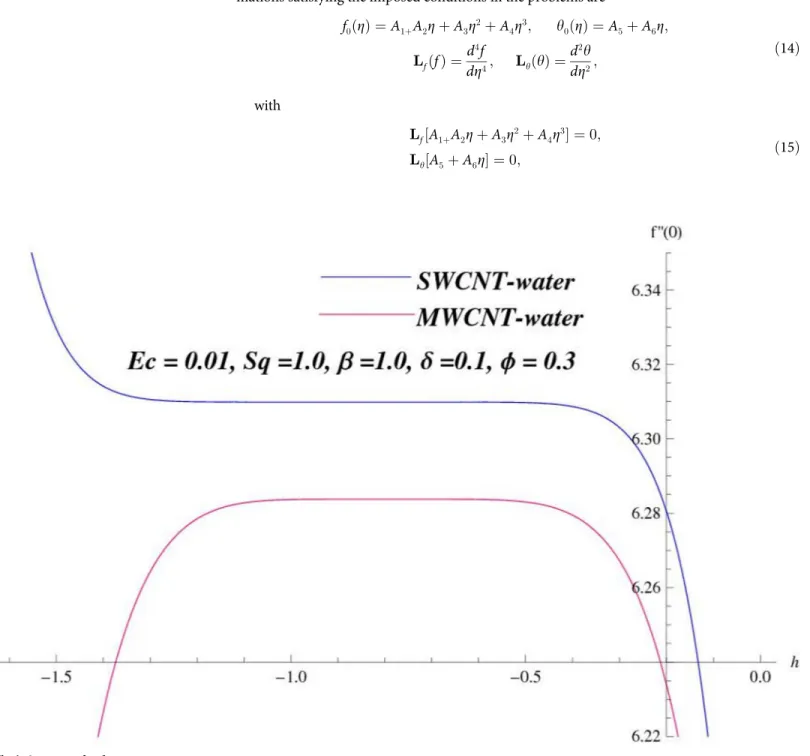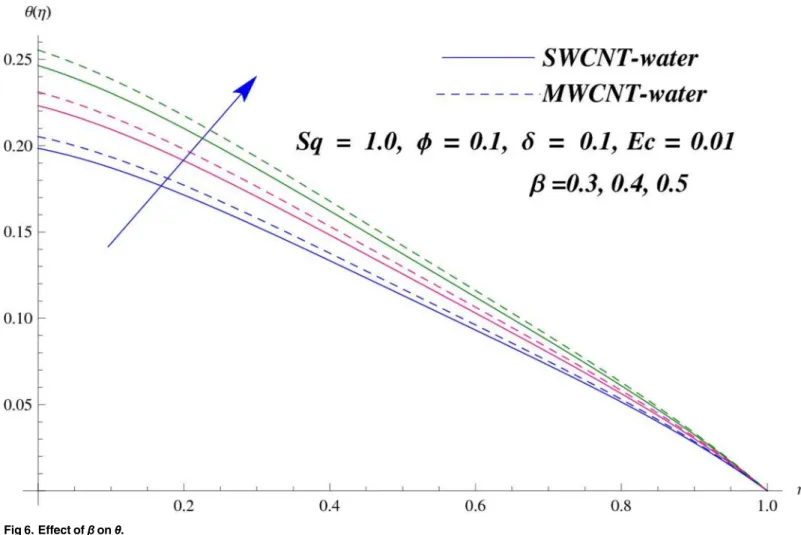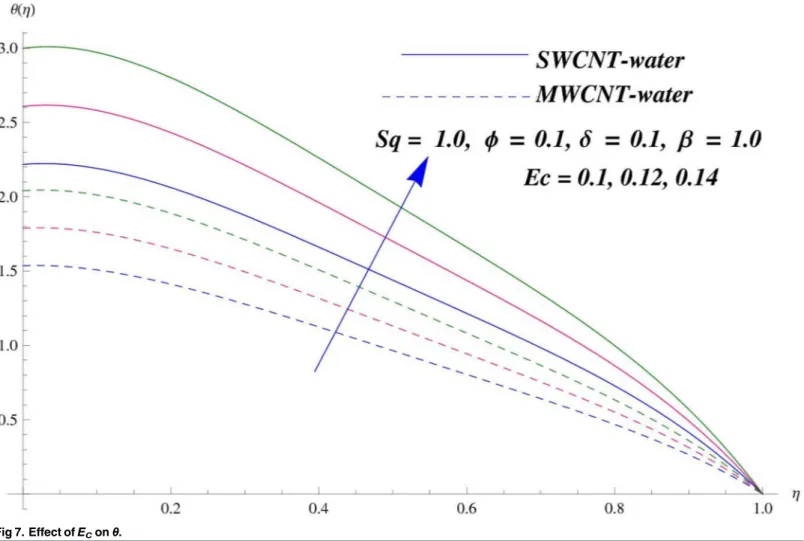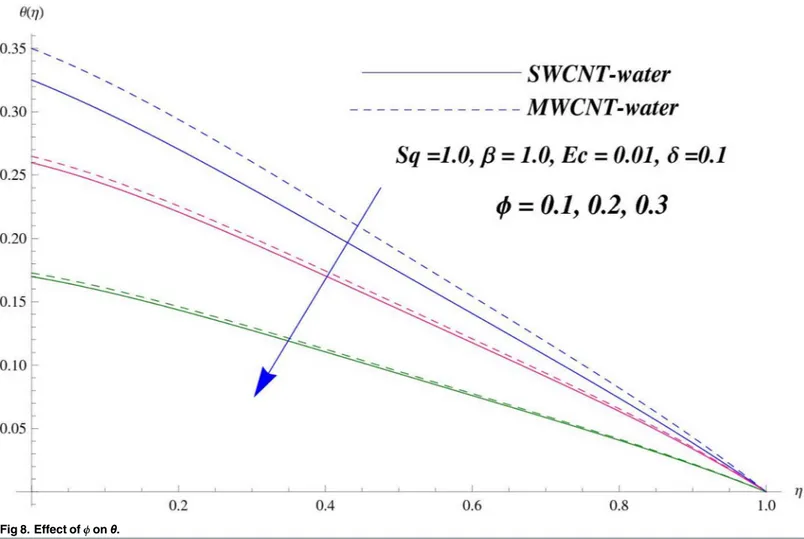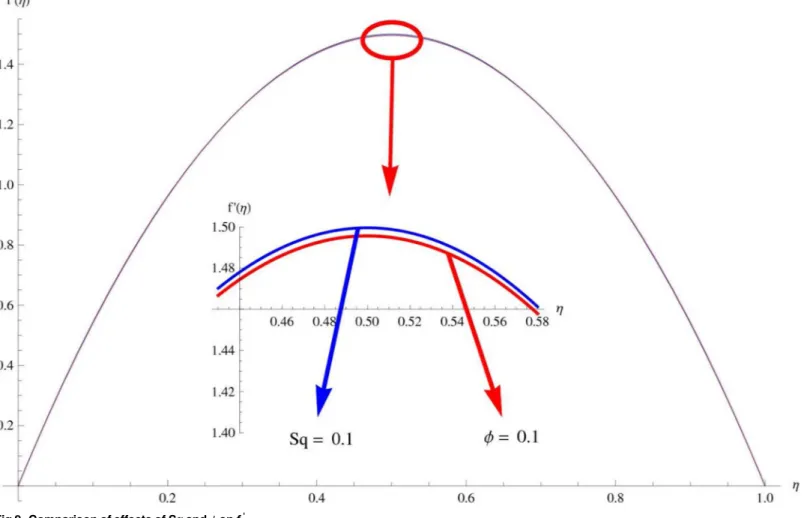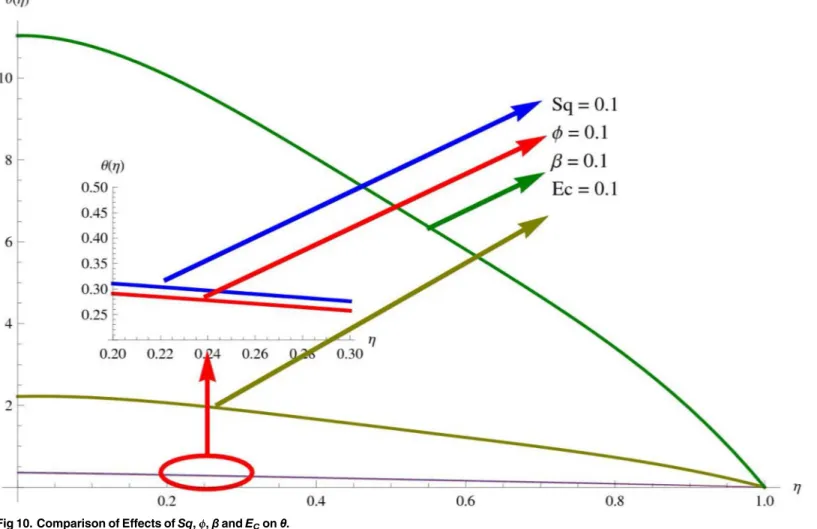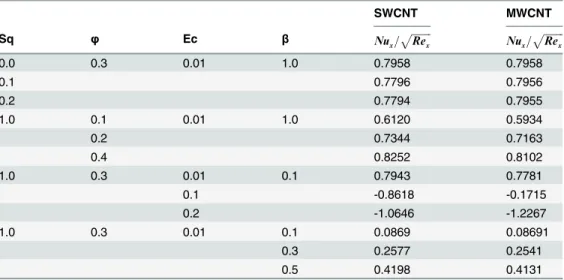Unsteady Squeezing Flow of Carbon Nanotubes
with Convective Boundary Conditions
Tasawar Hayat1,2, Khursheed Muhammad1, Muhammad Farooq1,3*, Ahmad Alsaedi2
1Department of Mathematics, Quaid-I-Azam University, 45320, Islamabad, 44000, Pakistan,2Nonlinear Analysis and Applied Mathematics (NAAM) Research Group, Department of Mathematics, Faculty of Science, King Abdulaziz University, P. O. Box 80257, Jeddah, 21589, Saudi Arabia,3Department of Mathematics, Riphah International University, Islamabad, 44000, Pakistan
*hfarooq99@yahoo.com
Abstract
Unsteady flow of nanofluids squeezed between two parallel plates is discussed in the pres-ence of viscous dissipation. Heat transfer phenomenon is disclosed via convective bound-ary conditions. Carbon nanotubes (single-wall and multi-wall) are used as nanoparticles which are homogeneously distributed in the base fluid (water). A system of non-linear differ-ential equations for the flow is obtained by utilizing similarity transformations through the conservation laws. Influence of various emerging parameters on the velocity and tempera-ture profiles are sketched graphically and discussed comprehensively. Analyses of skin fraction coefficient and Nusselt number are also elaborated numerically. It is found out that velocity is smaller for squeezing parameter in the case of multi-wall carbon nanotubes when compared with single-wall carbon nanotubes.
Introduction
Due to the rapid progress in thermal engineered systems and heat exchangers, enhancement of rate of heating or cooling has always been in demands for heating/cooling industrial processes. Poor heat transfer properties of traditional coolants have been an indispensable challenge for the scientists and engineers in heat transfer media and limits their applications. In fact, the working fluids play a major contribution in the cooling systems. However, the conventional heat transfer fluids such as water, oil and ethylene glycol, have relatively low thermal conduc-tivities. In this direction a great interest has been shown by the scientists and engineers in order to improve the thermal properties of these fluids. Recently great interest has been developed to analyze the heat transfer via nanofluid. Nanofluids are actually homogenous mixture of base fluid and nanoparticle with size (10–100 nm) diameter. Nanofluid is considered as a promising
way for enhancing the capability of heat transfer in fluids. In fact, the outstanding feature of a nanofluid is its superior thermal conductivity comparing to base fluid. Nanoparticles are made from different materials, such as oxide ceramics (Al2o3, Cuo), metal nitrides (AlN, SiN),
car-bide ceramics (SiC, TiC), metals (Cu, Ag, Au), carbons (e.g., diamond, graphite, carbon nano-tubes, fullerene) and functionalized nanoparticles. The term Nano was first introduced by Choi [1]. Nowadays carbon nanoparticles are utilized due to their higher thermal conductivity. Rate a11111
OPEN ACCESS
Citation:Hayat T, Muhammad K, Farooq M, Alsaedi A (2016) Unsteady Squeezing Flow of Carbon Nanotubes with Convective Boundary Conditions. PLoS ONE 11(5): e0152923. doi:10.1371/journal. pone.0152923
Editor:Bing-Yang Cao, Tsinghua University, CHINA
Received:February 27, 2016
Accepted:March 21, 2016
Published:May 5, 2016
Copyright:© 2016 Hayat et al. This is an open access article distributed under the terms of the
Creative Commons Attribution License, which permits unrestricted use, distribution, and reproduction in any medium, provided the original author and source are credited.
Data Availability Statement:All relevant data are within the paper.
Funding:The authors have no support or funding to report.
of heat transfer of nanofluids highly depends upon the shape of nanoparticles. The effect of shape of nanoparticles on the heat transfer and thermodynamics performance are studied by Elias et al. [2] and it is found that cylindrical shaped nanoparticle (nanotubes) have better per-formance in terms of thermal conductivity, heat transfer coefficients and heat transfer rate. Best performance was found for tubes shaped nanoparticle in comparison to bricks, blades, platelets and spherical shaped nanoparticles respectively. A carbon nanotube is a tube-shaped material made of carbon and having a diameter measuring on the nanometer scale. On the basis of structure, the carbon nanotubes are categorized in single-wall and multi-wall carbon nanotubes (SWCNTs and MWCNTs). Carbon nanotubes have wide range of applications such as conductive plastics, structural composite materials, flat-panel displays, gas storage, antifoul-ing paint, micro and nanoelectronics, radar-absorbantifoul-ing coatantifoul-ing, technical textiles, ultra-capaci-tors, atomic force microscope (AFM) tips, batteries with improved lifetime, biosensors for harmful gases, extra strong fibres etc. CNTs are used in medical devices and biosensors due to their higher chemical compatibility with biomolecules, i.e. proteins and DNA and also for puri-fication of contaminated drinking water [3]. In a sheared fluid the orientation of a rigid carbon nanotube and controlling its orientation is investigated by Dong and Cao [4]. In steady and transient flow the orientation of multi-wall carbon nanotube (MWCNT) is studied by Pujari et al. [5]. Turkyilmazoglu [6] explored the heat transfer characteristics of nanofluids due to a rotating disk. Dong and Cao [7] examined the unidirectional superhigh-speed rotatation of carbon nanotubes in linear shear flow. Nayak et al. [8] studied the mixed convection and entropy generation in Cu-water nanofluids in a heated skewed enclosure. Kherbeet et al. [9] performed an experiment to analyze the flow and heat transfer characteristics of nanofluids over a microscale. Peristaltic transport of water based nanofluids is mathematically modeled and studied by Shehzad et al. [10]. Sheikholeslami et al. [11] explored the characteristics of heat transfer for Fe3O4-water nanofluids with non-uniform magnetic field and forced
convec-tion. Effect of slip and wall properties on the peristaltic motion of nanofluids with Joule heating and magnetic field are analyzed by Hayat et al. [12]. Hayat et al. [13] discussed the characteris-tics of carbon nanotubes in the flow of water with homogenous-heterogenous reactions.
Squeezing flow between parallel plates has gained a considerable interest by the scientists and engineers due its wide range of applications in industrial and biological processes. Such applica-tions involve polymers processing, compression, injection modeling, lubricant system, transient loading of mechanical components, food processing, cooling water and modeling of synthetics transportation inside living bodies. The characteristics of squeezing flow was initially studied by Stefan [14]. Magnetohydrodynamic squeezed flow of nanofluid over a sensor surface is investi-gated by Haq et al. [15] Features of unsteady squeezing flow of nanofluids between two parallel plates are investigated by Gupta and Ray [16]. Qayyum et al. [17] analyzed the time dependent squeezing flow of Jeffrey fluid between two parallel disks. Hayat et al. [18] analyzed mixed con-vection squeezing flow of an incompressible Newtonian fluid between two vertical plates. The features of squeezed nanofluid between two parallel plates are analyzed by Sheikholeslami et al. [19]. Dib et al. [20] presented the squeezing flow of nanofluids analytically.
Disclosing the properties of fluids subject to high rate of cooling or heating the scientists and researchers focus their attention only on the dispersion of Cu, Ag, Al2O3nanoparticles
within the base fluid. In this study we developed mathematical model for the squeezing flow analysis of high rate of heating or cooling of base fluids using single and multi-wall carbon nanotubes. Convective boundary conditions are used to sort out heat transfer characteristics. Convergent series solutions are developed by homotopy analysis method[21–27]. Influences of
Mathematical Formulation
We consider unsteady squeezing flow of nanofluid between two parallel plates. The lower plate
of the channel is fixed aty= 0 while the upper plate is aty¼hðtÞ ¼
ffiffiffiffiffiffiffiffiffiffiffi ufð1 ctÞ
a q
(which is squeez-ing towards the lower plate). Heat transfer characteristics are explored with viscous dissipation and convective boundary conditions. Two types of carbon nanotubes (single-wall and multi-wall carbon nanotubes) are used as nanoparticles. Water is chosen as a basefluid. Cartesian coordinates are selected in such a way thatx-axis is along theflow direction whiley-axis is nor-mal to it. According to these assumptions the conservation laws take the following forms [15]:
@u @xþ
@v
@y¼0; ð1Þ
rnf @u
@tþu @u @xþv
@u @y
¼ @@p
xþmnf @2u
@x2þ
@2u
@y2
; ð2Þ
rnf @v
@tþu @v @xþv
@v @y
¼ @@p
yþmnf @2v
@x2þ
@2v
@y2
; ð3Þ
@T @t þu
@T @xþv
@T @y ¼
knf
ðrcpÞnf @2
T @x2 þ
@2
T @y2
þ mnf ðrcpÞnf
4 @u @x
2
þ @@v
xþ @u @y
2!
: ð4Þ
The subjected boundary conditions are
u¼0; v¼0; knf @T
@y ¼g0ðTf TÞ; aty¼0;
u¼0; v¼vh¼ dh
dt; T ¼Th; asy¼hðtÞ:
ð5Þ
In the above expressionsuandvdenote the velocity components in the x and y-direction respectively,pis the pressure,μnfis the dynamic viscosity of nanofluids,ρnfis the density of
nanofluids, (cp)nfis the specific heat of nanofluid,knfis the thermal conductivity of nanofluids, vhis the velocity of the upper plate,Tis the temperature of the fluid,Tfis the temperature of
the heated fluid,his the distance between the plates,γ0is the heat transfer coefficient andThis
the temperature of the squeezing plate or upper plate.
Xue [28] analyzed that proposed nanofluid model is valid only for spherical or rotational elliptical particles with small axial ratio. These models do not describe the properties of space distribution of the CNTs on thermal conductivity. To fill this void, Xue [28] proposed a theo-retical model based on Maxwell theory considering rotational elliptical nanotubes with very large axial ratio and compensating the effects of space distribution on CNTs.
The values appeared in Eqs (2) and (3) are
mnf ¼ mf
ð1 Þ2:5; nnf ¼
mnf
rnf; rnf ¼ ð1 Þrf þrCNT;
anf ¼ knf rnfðcpÞnf
; knf kf
¼ð
1 Þ þ2kCNT kCNT kfln
kCNTþkf
2kf
ð1 Þ þ2k kf CNT kfln
kCNTþkf
2kf ;
ð6Þ
thefluid,kfandknfare the thermal conductivities offluid and nanofluids respectively while kCNTis the thermal conductivity of carbon nanotubes.
Transformations are taken as follows:
Z¼ y
Hpffiffiffiffiffiffiffiffiffiffiffiffi1 ct; u¼ ax 2ð1 ctÞ
f0ðZÞ; H¼
ffiffiffiffi uf a r
v¼ aH
2pffiffiffiffiffiffiffiffiffiffiffiffi1 ctfðZÞ; yðZÞ ¼ T Th Tf Th :
ð7Þ
Incompressibility condition (1) is satisfied automatically and after eliminating pressure gra-dient from Eqs (2) and (3) and then applying these transformations the law of conservation of momentum and energy are reduced as follow:
1
ð1 Þ2:5 1 þrCNT rf 0 B @ 1 C Af 0000 Sq
2ð3f
@þZf000Þ f0f@þff000¼0; ð8Þ
knf=kf
1 þðrcpÞCNT
ðrcpÞf
0 @ 1 Ay @
þPrSqðfy0 Zy0Þ þ PrEc
ð1 Þ2:5ðf 002
þ4d2f02
Þ ¼0; ð9Þ
with the boundary conditions
fð0Þ ¼0; f0ð0Þ ¼0; y0
ð0Þ ¼ kb
nf kf
ð1 yð0ÞÞ;
fð1Þ ¼1; f0ð1Þ ¼0 yð1Þ ¼0
ð10Þ
whereSqis the squeezing parameter,Ecis the Eckert number, Pr is the Prandtl number,βis the Biot number andδis the length parameter. These parameters are
Sq¼c
a; Pr¼ mfcp
k ; b¼ g0H
ffiffiffiffiffiffiffiffiffiffiffiffi 1 ct
p
kf ;
Ec¼ a
2x2
4cpð1 atÞ
2
ðTh TfÞ
; d¼H
ffiffiffiffiffiffiffiffiffiffiffiffi 1 ct
p
x :
ð11Þ
Skin friction coefficient and local Nusselt number are given by
tw¼mnf @u
@y
y¼0
; qw¼ knf @T
@y
y¼0
;
Cf ¼ tw rfU2
w
; Nux¼ xqw kfðTf ThÞ
:
ð12Þ
Dimensionless skin friction coefficient and local Nusselt number are
CfRe
1=2
x ¼
1
ð1 Þ2:5f
@ð0Þ; Nu xRe
1=2
x ¼
knf kf
y0ð0Þ; ð13Þ
Homotopic Solutions
Homotopy analysis method (HAM) is proposed by Liao [22] in 1992, used to find the solution of nonlinear differential equations. Homotopy analysis method has several advantages such as (i) it is independent of small or large values of the parameters. (ii) It guarantees the conver-gence of the solution and (iii) it provides a great freedom for the selection of base function and linear operator.
As homotopy analysis method gives the series solution of any differential equation, there-fore it requires the initial approximations to proceed the series solutions. Here initial approxi-mations satisfying the imposed conditions in the problems are
f0ðZÞ ¼A1þA2ZþA3Z 2
þA4Z
3; y
0ðZÞ ¼A5þA6Z;
L fðfÞ ¼
d4f
dZ4; LyðyÞ ¼
d2y
dZ2;
ð14Þ
with
L
f½A1þA2ZþA3Z 2þA
4Z 3 ¼0;
L
y½A5þA6Z ¼0;
ð15Þ
Fig 1.ℏ–curves forf.
whereAi(i= 1,2,. . .,6) are the arbitrary constants. The zeroth andmth order deformation
problems are:
Zeroth-Order Problem
ð1 pÞL f½f
_
ðZ;pÞ f0ðZÞ ¼pℏfNf½f
_
ðZ;pÞ;y_ðZ;pÞ;
ð1 pÞL y½y
_
ðZ;pÞ y0ðZÞ ¼pℏyNy½y _
ðZ;pÞ;f
_ ðZ;pÞ;
f
_
ð0;pÞ ¼0; _f
0
ð0;pÞ ¼0; _fð1;pÞ ¼1; _f
0
ð1;pÞ ¼0;
ð16Þ
y _0
ð0;pÞ ¼ kbnf kf
ð1 y_ð0;pÞÞ; _yð1;pÞ ¼0; ð17Þ
Fig 2.ℏ
–curves forθ.
N f½f
_
ðZ;pÞ;_yðZ;pÞ ¼ 1 ð1 Þ2:5 1 þrCNTrf
0 B @ 1 C A
@4_f ðZ;pÞ
@Z4
Sq Z
@3_f ðZ;pÞ
@Z3 þ3
@2_f ðZ;pÞ
@Z2 þ
@_fðZ;pÞ
@Z
@2_f ðZ;pÞ
@Z2 f _
ðZ;pÞ
@3_f ðZ;pÞ
@Z3 0 B B @ 1 C C A ;
ð18Þ
N y½y
_
ðZ;pÞ;_fðZ;pÞ ¼ knf=kf
1 þðrcpÞCNT
ðrcpÞf
0 B B @ 1 C C A
@2_y
ðZ;pÞ
@Z2 þPrSq f
_
ðZ;pÞ @y
_
ðZ;pÞ
@Z Z
@y _
ðZ;pÞ
@Z 0 B @ 1 C A
þ PrEc ð1 Þ2:5
@2_y
ðZ;pÞ
@Z2 0 B @ 1 C A 2
þ4d2
@f_ðZ;pÞ
@Z 0 B B @ 1 C C A 2 0 B B @ 1 C C A ;
ð19Þ
in whichp2[0,1] is embedding parameter andℏf,ℏθare the non-zero auxiliary parameters.
m
th-Order Deformation Problems
Here
L
f½fmðZÞ wmfm 1ðZÞ ¼ℏfR f mðZÞ;
L
y½ymðZÞ wmym 1ðZÞ ¼ℏyR y mðZÞ;
ð20Þ
fmð0Þ ¼0; fm0ð0Þ ¼0; fmð1Þ ¼0; fm0ð1Þ ¼0;
y0mð0Þ ¼ b knf kf
ymð0Þ; ymð1Þ ¼0; ð21Þ
Rf mðZÞ ¼
1
ð1 Þ2:5 1 þrCNT rf
0
B @
1
C Af
0000
m 1
Sq 2ð3f
00
m 1þZf 000
m 1Þ þ Xm
1
k¼0 ðfm0 1 kf
00
k fm 1 kfk000Þ; ð22Þ Fig 4. Effect ofϕonf'.
Ry mðZÞ ¼
knf=kf
1 þðrcpÞCNT
ðrcpÞf
0
B B @
1
C C A
y00m 1þPrSq Xm
1
k¼0
fm 1 ky
0
k Zy
0
m 1 !
þ PrEc ð1 φÞ2:5
Xm 1
k¼0
f00
m 1 kfk00þ4d
2
f0
m 1 kfk0
;
ð23Þ
wm¼
(
0; m1
1; m>1: ð24Þ
Forp= 0 andp= 1, we can write
f
_
ðZ; 0Þ ¼f0ðZÞ; f _
ðZ; 1Þ ¼fðZÞ;
y _
ðZ; 0Þ ¼y0ðZÞ; y _
ðZ; 1Þ ¼yðZÞ;
ð25Þ
and with the variation ofpfrom 0 to 1,f_ðZ;pÞand_yðZ;pÞvary from the initial solutionsf0(η)
andθ0(η) to thefinal solutionsf(η) andθ(η) respectively. By Taylor series we have
f
_
ðZ;pÞ ¼f0ðZÞ þ X1
m¼1
fmðZÞp m; f
mðZÞ ¼ 1 m!
@m_fðZ;pÞ
@pm p¼0
;
y _
ðZ;pÞ ¼y0ðZÞ þ X1
m¼1
ymðZÞpm; y mðZÞ ¼
1 m!
@m_yðZ;pÞ
@pm p¼0
:
ð26Þ
The value of auxiliary parameter is chosen in such a way that the series (32) and (33) con-verge atp= 1 i.e.
fðZÞ ¼f0ðZÞ þ X1
m¼1
fmðZÞ;
yðZÞ ¼y0ðZÞ þ X1
m¼1 ymðZÞ:
ð27Þ
The general solutions (fm,θm) of Eqs (24) and (25) in terms of special solutionsðfm;y
mÞare Fig 6. Effect ofβonθ.
given by
fmðZÞ ¼f
?
mðZÞ þA1þA2ZþA3Z 2
þA4Z 3;
ymðZÞ ¼y?mðZÞ þA5þA6Z;
ð28Þ
Convergence Analysis
Homotopy analysis method was first proposed by Liao [21] in 1992 which is used to obtain the solutions of highly nonlinear problems. The h-curves in Figs1and2are displayed for convergence region. The admissible ranges of the auxiliary parametersℏfandℏθfor SWCNT
case are−1.26ℏf−0.5 and−0.56ℏθ−0.1 while for MWCNT case these values
are−1.3ℏf−0.52 and−0.57ℏθ−0.18.
Discussion
The main purpose of this section is to elaborate the physical behavior of various pertinent parameters on the velocity and temperature distributions corresponding to single and multi-wall carbon nanotubes.Fig 3shows the effect of squeezing parameterSqon the velocity profile. HereSq<0 corresponds to the motion of upper plate away from the lower plate. It provides more space between the plates in which fluid to be imprisoned. To fill this space, the fluid
moves in reverse direction and thus velocity profile decreases. SimilarlySq>0 corresponds to the motion of the upper plate towards the lower plate, due to which a force (squeezing force) is experienced by the fluid which is responsible for the motion of the fluid with more velocity. As a result, velocity profiles enhances. Further the velocity profile is dominant for the multi-wall carbon nanotubes when compared with single-wall carbon nanotubes. Behavior of nanoparti-cle volume fractionϕon the velocity distribution is portrayed inFig 4. It is observed that the velocity profile reduces for larger values of nanoparticle volume fraction near the plates while it enhances away from the plates for both SWCNTs and MWCNTs cases. Also the effect of MWCNTs dominants over SWCNTs due to the low density. Impact of squeezing parameterSq on the temperature profile is depicted inFig 5. It is analyzed that squeezing parameterSq<0. i.e., when squeezing plate moves away from the lower plate then there is reduction of tempera-ture profile while opposite behavior is observed forSq>0, i.e., when the squeezing plate moves towards the lower plate. Further MWCNTs show dominant behavior when compared to SWCNTs. Analysis of Biot numberβon the temperature profile is sketched inFig 6for both SWCNTs and MWCNTs cases. Temperature profile shows increasing behavior for larger val-ues ofβ. In fact, when we increase Biot number, the heat transfer rate increases which is responsible for rise in temperature of the fluid. Behavior of Eckert numberEcon the tempera-ture profile is displayed inFig 7. It is noted that temperature profile is higher for larger values of Eckert number. In fact, larger Eckert number corresponds to higher drag forces between the
Fig 8. Effect ofϕonθ.
fluid particles. As a result, more heat is produced and thus temperature profile increases. Analysis of nanoparticle volume fractionϕon temperature distribution is illustrated inFig 8for SWCNTs and MWCNTs. Temperature distribution shows decreasing behavior for larger nanoparticle volume fraction. Single-wall carbon nanotubes show dominant behavior on the temperature dis-tribution than the multi-wall carbon nanotubes.Fig 9is sketched to compare the effects of squeezing parameterSqand nanoparticle volume fractionϕon the velocity profile. It is observed that the effect ofSqis more than dominantϕon the velocity of the fluid.Fig 10is portrayed for comparison of effects ofϕ,Sq,Ecandβon the temperature profile. It is found out that the effect ofβis maximum on the temperature profile which is followed byEc,Sqandϕ.
Table 1demonstrates the thermophysical properties (i.e., density, specific heat and thermal conductivity) of the base fluid water and carbon nanotubes.Table 2displays the convergence of series solutions for the conservation laws of momentum and energy. It is noted that 67thand 60thorder of approximations are sufficient for the convergence of momentum and energy equations in the case of SWCNTs respectively. However for MWCNTs the 67thand 50thorder of approximations are sufficient for the convergence of momentum and energy equations.
Table 3is prepared for the numerical values of skin friction coefficient for different values of various pertinent parameters. It is observed that the skin friction coefficient is higher for larger values of squeezing parameterSq, nanoparticle volume fractionfand Biot numberβwhile it decreases for larger Eckert number for both single-wall and multi-wall carbon nanotubes.
Fig 9. Comparison of effects ofSqandϕonf'.
Table 4is presented for the numerical values of Nusselt number under the influence of various involved parameters. It is found out that the rate of heat transfer reduces for larger values of squeezing parameterSqand Eckert numberEcin both single-wall and multi-wall carbon nano-tubes (SWCNTs and MWCNTs) while the rate of heat transfer increases for larger values of nanoparticle volume fractionϕand Biot numberβin both SWCNTs and MWCNTs cases.
Closing Remarks
In the present analysis we have disclosed the characteristics of unsteady squeezing flow of car-bon nanotubes (single-wall and multi-wall carcar-bon nanotubes) in the channel of two infinite parallel plates. The key points are summarized as follows:
Fig 10. Comparison of Effects ofSq,ϕ,βandEConθ. doi:10.1371/journal.pone.0152923.g010
Table 1. Numerical values of thermophysical properties of base fluid and nanoparticles [13] (i.e. density, specific heat and thermal conductivity).
Physical Porperties Basefluid Nanoparticles
Water SWCNTs MWCNTs
ρ(kg/m3) 997 2600 1600
cp(J/kgK) 4179 425 796
k(W/mK) 0.613 6600 3000
Table 3. Numerical values of skin friction coefficient for different values of various pertinent parame-ters for both SWCNTs and MWCNTs whenδ= 0.1.
SWCNT MWCNT
Sq φ Ec β Cf
ffiffiffiffiffiffiffiffi
Rex
p
Cf
ffiffiffiffiffiffiffiffi
Rex
p
0.0 0.3 0.01 1.0 14.64 14.64
0.1 14.684 14.675
0.2 14.740 14.719
1.0 0.1 0.01 1.0 8.2113 8.17736
0.2 10.9425 10.8739
0.4 22.095 21.9552
1.0 0.3 0.01 0.1 15.1547 15.0509
0.1 15.1547 15.0509
0.2 15.1546 15.0507
1.0 0.3 0.01 0.1 15.1546 15.052
0.3 15.1547 15.0509
0.5 15.1548 15.051
doi:10.1371/journal.pone.0152923.t003
Table 4. Numerical values of Nusselt number for different values of various pertinent parameters for both SWCNTs and MWCNTs whenδ= 0.1.
SWCNT MWCNT
Sq φ Ec β Nux= ffiffiffiffiffiffiffiffi
Rex
p
Nux= ffiffiffiffiffiffiffiffi
Rex
p
0.0 0.3 0.01 1.0 0.7958 0.7958
0.1 0.7796 0.7956
0.2 0.7794 0.7955
1.0 0.1 0.01 1.0 0.6120 0.5934
0.2 0.7344 0.7163
0.4 0.8252 0.8102
1.0 0.3 0.01 0.1 0.7943 0.7781
0.1 -0.8618 -0.1715
0.2 -1.0646 -1.2267
1.0 0.3 0.01 0.1 0.0869 0.08691
0.3 0.2577 0.2541
0.5 0.4198 0.4131
doi:10.1371/journal.pone.0152923.t004
Table 2. Convergence of series solutions for different order of approximations whenδ= 0.1,ϕ= 0.3,β= 1.0,Sq= 1.0 andEc= 0.01.
SWCNT MWCNT
Order of approximations f00(0) -θ0(0) f00(0) -θ0(0)
1 6.03571 0.241736 6.03571 0.253125
10 6.21878 0.211558 6.20982 0.218798
20 6.28308 0.210468 6.26448 0.217195
30 6.302 0.210431 6.27874 0.217133
40 6.30756 0.210426 6.28246 0.217128
50 6.30921 0.210424 6.28343 0.217126
60 6.30969 0.210423 6.28368 0.217126
67 6.30981 0.210423 6.28374 0.217126
70 6.30981 0.210423 6.28374 0.217126
➢ Velocity distribution shows decreasing behavior for squeezing parameterSqand increas-ing behavior for nanoparticle volume fractionϕ. Also velocity dominants in case of multi-wall carbon nanotubes.
➢ Temperature profile is higher for multi-wall carbon nanotubes than the single-wall carbon nanotubes when there is an increase in squeezing parameterSq, nanoparticles volume fractionϕ, Biot numberβand Eckert numberEc.
➢ Higher values of squeezing parameterSqenhance the skin friction coefficient but it is lower for MWCNT than the SWCNT case.
➢ Higher values of nanoparticle volume fractionϕ, Eckert numberEcand Biot numberβ result in the enhancement of skin friction coefficient for both SWCNTs and MWCNTs cases. However, the effect of SWCNTs dominants over MWCNTs.
➢ Cooling process or rate of heat transfer can be enhanced by using smaller values of squeezing parameter and Eckert number while it increase for larger values of Biot number βand nanoparticle volume fractionϕ. The case of SWCNT is found more efficient.
Author Contributions
Conceived and designed the experiments: TH KM MF AA. Performed the experiments: TH KM MF AA. Analyzed the data: TH KM MF AA. Contributed reagents/materials/analysis tools: TH KM MF AA. Wrote the paper: TH KM MF AA.
References
1. Choi S U S, (1995) Enhancing thermal conductivity of fluids with nanoparticles, Development and Appli-cation of non-Newtonian flows. Siginer D. A. and Wang H. P., eds. FED-vol. 231/MD 66, ASME, New York, 99–105.
2. Elias M M, Miqdad M, Mahbubul I M, Saidur R, Kamalisarvestani M, Sohel M R, et al. (2013) Effect of nanoparticle shape on the heat transfer and thermodynamic performance of a shell and tube heat exchanger. Int. Commu. Heat Mass Transfer 44: 93–99.
3. Volder M F L D, Tawfick S H, Baughman R H, and Hart A J, (2013) Carbon nanotubes: present and future commercial applications. Science 339: 535–539. doi:10.1126/science.1222453PMID:
23372006
4. Dong R Y, and Cao B, (2014) Anomalous orientations of a rigid carbon nanotube in a sheared fluid, Sci. Rep. 4: 6120. doi:10.1038/srep06120PMID:25134626
5. Pujari S, Rahatekar S S, Gilman J W, Koziol K K, Windle A H, and Burghardt W R, (2009) Orientation dynamics in multiwalled carbon nanotube dispersions under shear flow, J. Chem. Phys. 130 214903. doi:10.1063/1.3139446PMID:19508094
6. Turkyilmazoglu M, (2014) Nanofluid flow and heat transfer due to rotating disk. Computer & Fluids 94: 139–146.
7. Dong R Y, and Cao B Y, (2015) Superhighspeed unidirectional rotation of a carbon nanotube in a sheared fluid and its decoupled dynamics, RSC Advances, 5: 8871988724.
8. Nayak R K, Bhattacharyya S, and Pop I, (2015) Numerical study on mixed convection and entropy gen-eration of Cu—water nanofluid in a differentially heated skewed enclosure. Int. J. Heat Mass Transfer 85 620–634.
9. Kherbeet A Sh, Mohammed H A, Salmanc B H, Ahmed H E, Alawi O A, and Rashidi M M, (2015) Exper-imental study of nanofluid flow and heat transfer over microscale backward- facing and forward-facing steps. Experimental Thermal and Fluid Science 65 13–21.
10. Shehzad S A, Abbasi F M, Hayat T, and Alsaedi F, Model and comparative study for peristaltic transport of water based nanofluids. J. Mol. Liq. 209 (2015) 723–728.
12. Hayat T, Nisar Z, Ahmad B, and Yasmin H, (2015) Simultaneous effects of slip and wall properties on MHD peristaltic motion of nanofluid with Joule heating. J. Mag. Mag.Mater. 395 48–58.
13. Hayat T, Farooq M, and Alsaedi A, (2015) Homogenous-heterogenous reactions in the stagnation point flow of carbon nanotubes with Newtonian heating. AIP Advances 5 027130.
14. Stefan M J, (1874) Versuch ber die scheinbare adhesion. Akad Wissensch Wien Math Natur 69 p. 713. 15. Haq R U, Nadeem S, Khan Z H and Noor N F M, (2015) MHD squeezed flow of water functionalized
metallic nanoparticles over a sensor surface. Physica E: Low-dimensional Systems and Nanostructure 73 45–53.
16. Gupta A K, and Saha Ray S, (2015) Numerical treatment for investigation of squeezing unsteady nano-fluid flow between two parallel plates. Powder Tech. 279 282–289.
17. Qayyum A, Awais M, Alsaedi A, and Hayat T, (2012) Unsteady squeezing flow of jeffrey fluid between two parallel disks. Chin. Phys. Lett. 29 034701.
18. Hayat T, Qayyum A, and Alsaedi A, (2015) Three-dimensional mixed convection squeezing flow. Appl. Math. Mech. 36 47–60.
19. Sheikholeslami M, Ganji D D, and Ashorynejad H R, (2013) Investigation of squeezing unsteady nano-fluid flow using ADM. Powder Tech. 239 259–265.
20. Dib A, Haiahem A, and Bou-said B, (2015) Approximate analytical solution of squeezing unsteady nanofluid flow. Powder Tech. 269 193–199.
21. Liao S J, (2012) Homotopy analysis method in non-linear differential equations, Springer and Higher Education Press, Heidelberg.
22. Hayat T, Anwar M S, Farooq M, and Alsaedi A, (2015) Mixed convection flow of viscoelastic fluid by a stretching cylinder with heat transfer. Plos One. 10: e0118815. doi: 10.1371 PMID:25775032
23. Shehzad S A, Alsaedi A, and Hayat T, (2013) Hydromagnetic steady flow of Maxwell fluid over a bidi-rectional stretching surface with prescribed surface temperature and prescribed surface heat flux. Plos One. 8: e78240. doi: 10.1371 PMID:24223780
24. Han S, Zheng L, Li C, and Zhang X, (2014) Coupled flow and heat transfer in viscoelastic fluid with Cat-taneo-Christov heat flux model. Appl. Math. Lett. 38 87–93.
25. Hayat T, Qayyum S, Imtiaz M, and Alsaedi A, (2016) Impact of Cattaneo-Christov heat flux in Jeffrey fluid flow with homogeneous-heterogeneous reactions. Plos One. 11: e0148662. doi: 10.1371 PMID:
26859675
26. Hayat T, Shafiq A, and Alsaedi A, (2014) Effect of Joule heating and thermal radiation in flow of third grade fluid over radiative surface. Plos One. 9: e83153. doi: 10.1371 PMID:24454694
27. Abbasbandy S, and Jalil M, (2013) Determination of optimal convergence-control parameter value in homotopy analysis method. Numer. Algor. 64 593–605.
